RENAULT TWINGO RS 2009 2.G Chasiss ESP User Guide
Manufacturer: RENAULT, Model Year: 2009, Model line: TWINGO RS, Model: RENAULT TWINGO RS 2009 2.GPages: 101
Page 11 of 101
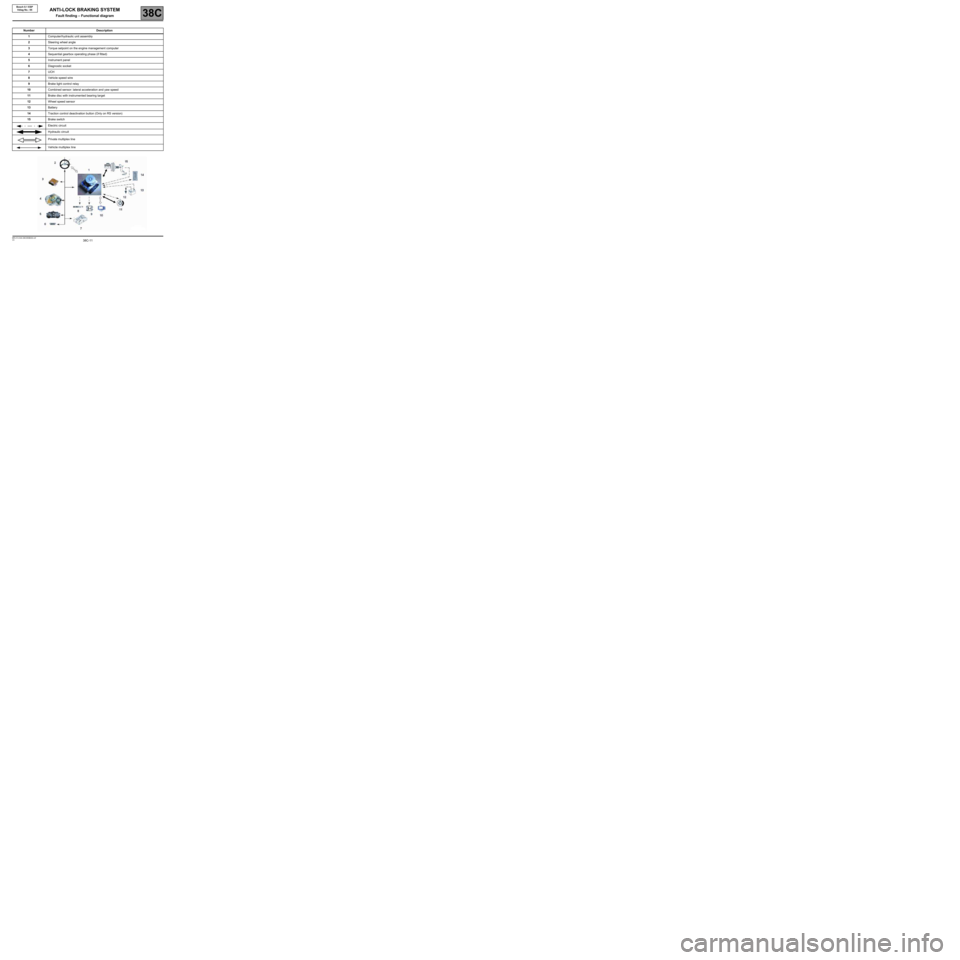
38C-11V3 MR-413-X44-38C050$030.mif
38C
Bosch 8.1 ESP
Vdiag No.: 05
Number Description
1Computer/hydraulic unit assembly
2Steering wheel angle
3Torque setpoint on the engine management computer
4Sequential gearbox operating phase (if fitted)
5Instrument panel
6Diagnostic socket
7 UCH
8Vehicle speed wire
9Brake light control relay
10Combined sensor: lateral acceleration and yaw speed
11Brake disc with instrumented bearing target
12Wheel speed sensor
13Battery
14Traction control deactivation button (Only on RS version)
15Brake switch
Electric circuit
Hydraulic circuit
Private multiplex line
Vehicle multiplex line
ANTI-LOCK BRAKING SYSTEM
Fault finding – Functional diagram
Page 12 of 101
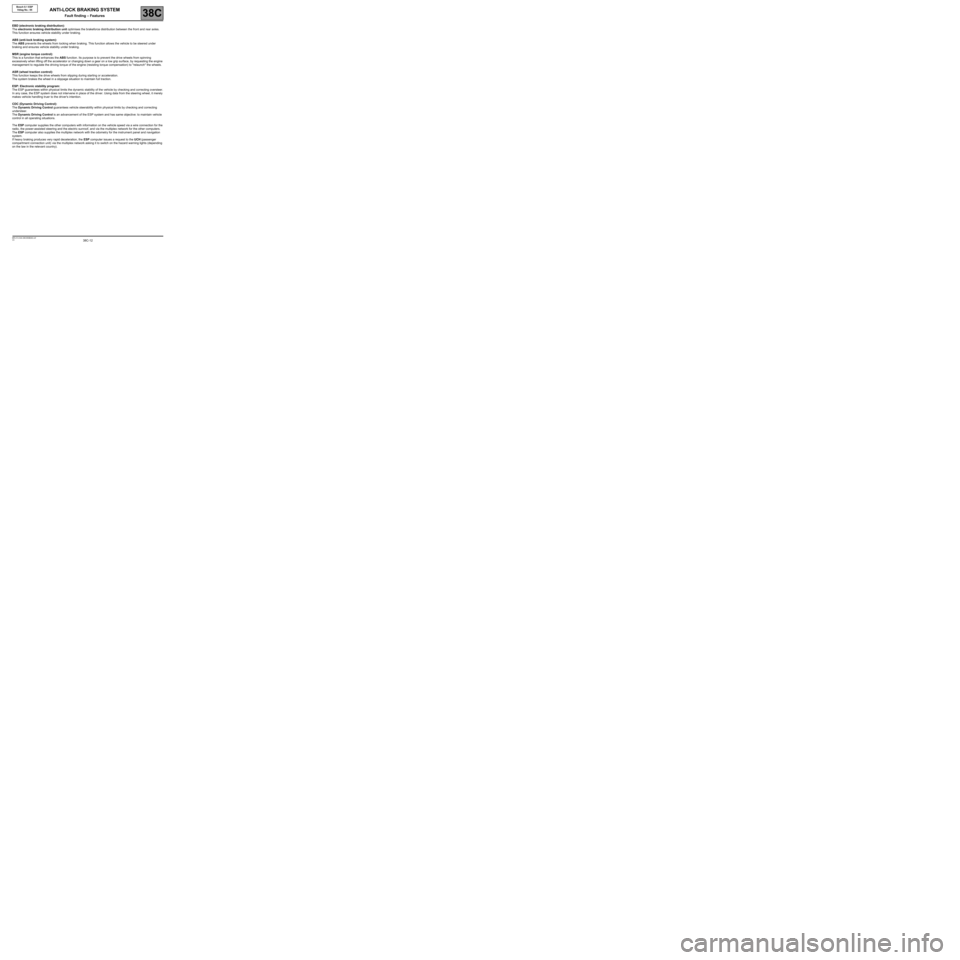
38C-12V3 MR-413-X44-38C050$040.mif
38C
Bosch 8.1 ESP
Vdiag No.: 05
EBD (electronic braking distribution):
The electronic braking distribution unit optimises the brakeforce distribution between the front and rear axles.
This function ensures vehicle stability under braking.
ABS (anti-lock braking system):
The ABS prevents the wheels from locking when braking. This function allows the vehicle to be steered under
braking and ensures vehicle stability under braking.
MSR (engine torque control):
This is a function that enhances the ABS function. Its purpose is to prevent the drive wheels from spinning
excessively when lifting off the accelerator or changing down a gear on a low grip surface, by requesting the engine
management to regulate the driving torque of the engine (resisting torque compensation) to "relaunch" the wheels.
ASR (wheel traction control):
This function keeps the drive wheels from slipping during starting or acceleration.
The system brakes the wheel in a slippage situation to maintain full traction.
ESP: Electronic stability program:
The ESP guarantees within physical limits the dynamic stability of the vehicle by checking and correcting oversteer.
In any case, the ESP system does not intervene in place of the driver. Using data from the steering wheel, it merely
makes vehicle handling truer to the driver's intention.
CDC (Dynamic Driving Control):
The Dynamic Driving Control guarantees vehicle steerability within physical limits by checking and correcting
understeer.
The Dynamic Driving Control is an advancement of the ESP system and has same objective: to maintain vehicle
control in all operating situations.
The ESP computer supplies the other computers with information on the vehicle speed via a wire connection for the
radio, the power-assisted steering and the electric sunroof, and via the multiplex network for the other computers.
The ESP computer also supplies the multiplex network with the odometry for the instrument panel and navigation
system.
If heavy braking produces very rapid deceleration, the ESP computer issues a request to the UCH (passenger
compartment connection unit) via the multiplex network asking it to switch on the hazard warning lights (depending
on the law in the relevant country).
ANTI-LOCK BRAKING SYSTEM
Fault finding – Features
Page 13 of 101

38C-13V3 MR-413-X44-38C050$050.mif
38C
Bosch 8.1 ESP
Vdiag No.: 05
Wheel speed sensors:
Give the speed of each of the vehicle's wheels. The analysis of the sensors allows the calculation of the vehicle
speed.
Brake lights switch:
Signals the position of the brake pedal (pressed or released).
Combined sensor (Dual sensor):
Indicates the lateral acceleration and the yaw speed of the vehicle. The analysis of these data combined with the
data from the other sensors allows the determination of the vehicle's path.
Steering wheel angle sensor:
Angular indication of the desired path of the vehicle.
ANTI-LOCK BRAKING SYSTEM
Fault finding – Role of components
Page 14 of 101

38C-14V3 MR-413-X44-38C050$060.mif
38C
Bosch 8.1 ESP
Vdiag No.: 05
Fault finding warning lights programming
Instrument panel warning light Meaning
Brake faultsABS system ESP SERVICE STOP"Brake limiter", ABS, and
ESP functions not working
ABS system ESP SERVICEESP and ABS functions not
working, "brake limiter"
operational
ESP SERVICEESP function not working, ABS
and "brake limiter"
operational
ESP
"Wheel traction control"
function deactivated by fault
finding orESPmomentarily
disco nnected a fter the battery is
disconnected
Brake faults
flashing
at 2 H z (slowly)ABS flashing
at 2 Hz
(slowly)ESP flashing
at 2 Hz (slowly)ESP computer in fault finding
mode
ESP flashing
at 8 Hz
(quickly)ESP or "wheel traction control"
or "anti-lock brake system on
engine torque control" active
ABS flashing
at 8 Hz
(quickly)Tachometric index not
programmed
Brake faults ABS systemESP flashing
at 8 Hz
(quickly)SERVICE STOPVehicle variant not
programmed
Brake faultsABS flashing
at 8 Hz
(quickly)ESP flashing
at 8 Hz
(quickly)STOPVehicle option and tachometric
index not programmed
Note:
The STOP warning light is always accompanied by a single audible warning (1 beep).
ANTI-LOCK BRAKING SYSTEM
Fault finding – Defect and safe modes
Page 15 of 101

38C-15V3 MR-413-X44-38C050$070.mif
38C
Bosch 8.1 ESP
Vdiag No.: 05
REPLACING THE COMPUTER:
When replacing the computer (see MR 411, Mechanical, 38C, Anti-lock braking system, Braking computer:
Removal - Refitting), use the following procedure:
–Switch off the ignition.
–Replace the computer.
–Enter the VIN number using command VP001 Enter VIN (see Configurations and Programming).
–Configure the tachometric index using command VP007 Tachometric index (see Configurations and
programming).
–Configure the vehicle parameters using command VP004 Vehicle parameters (see Configurations and
programming).
–Inhibit or authorise illumination of the automatic brake lights (depending on the country's legislation) using
command VP021 Inhibit automatic brake lights or VP022 Authorise automatic brake lights.
–Clear the ESP sensor offsets using command RZ011 Sensors offsets (see Configurations and programming).
–Enter the After-Sales date using command VP006 Enter last APV* operation date.
–Perform a road test followed by a fault reading to confirm that the system is operating correctly.
REPLACING THE STEERING WHEEL ANGLE SENSOR:
–Calibrate the steering wheel angle sensor using command VP003 Steering wheel angle sensor (see
Configurations and programming).
–Clear the ESP sensor offsets using command RZ011 Sensor offsets.
REPLACING THE COMBINED SENSOR:
–Clear the ESP sensor offsets using command RZ011 Sensor offsets.
* APV: After-Sales
ANTI-LOCK BRAKING SYSTEM
Fault finding – Replacement of components
Page 16 of 101
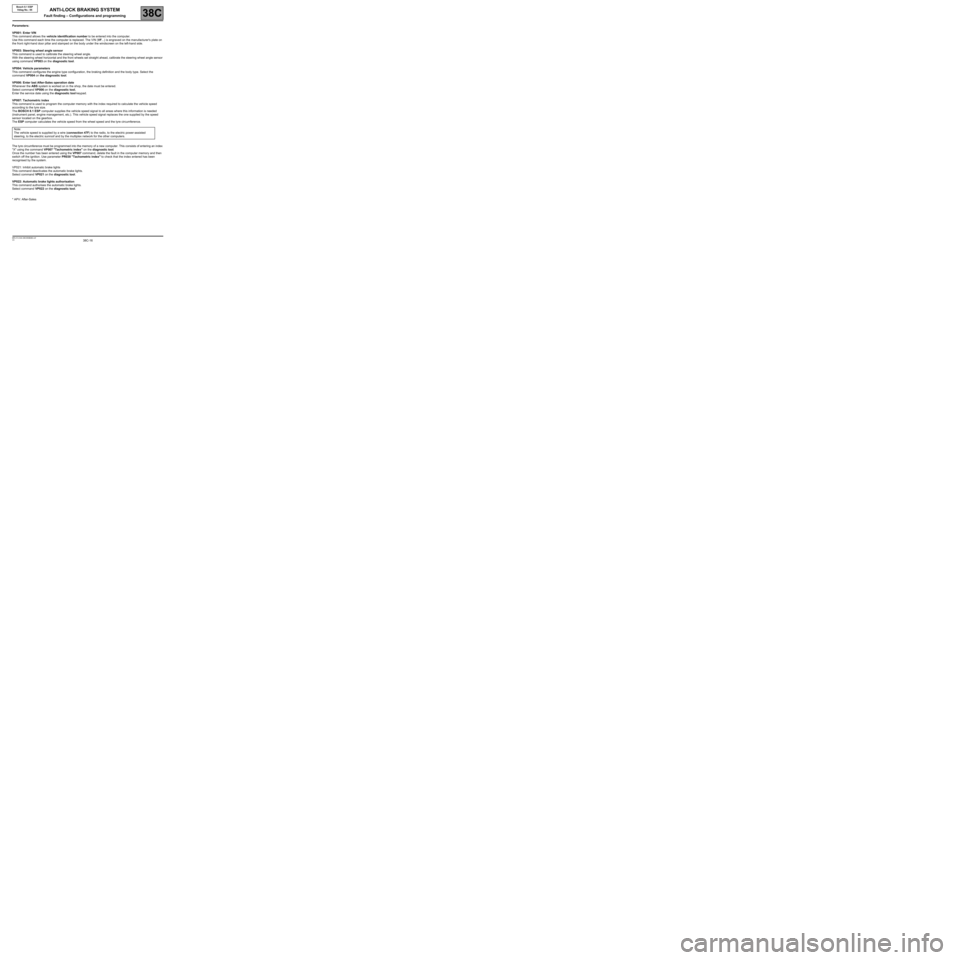
38C-16V3 MR-413-X44-38C050$080.mif
38C
Bosch 8.1 ESP
Vdiag No.: 05
Parameters:
VP001: Enter VIN
This command allows the vehicle identification number to be entered into the computer.
Use this command each time the computer is replaced. The VIN (VF...) is engraved on the manufacturer's plate on
the front right-hand door pillar and stamped on the body under the windscreen on the left-hand side.
VP003: Steering wheel angle sensor
This command is used to calibrate the steering wheel angle.
With the steering wheel horizontal and the front wheels set straight ahead, calibrate the steering wheel angle sensor
using command VP003 on the diagnostic tool.
VP004: Vehicle parameters
This command configures the engine type configuration, the braking definition and the body type. Select the
command VP004 on the diagnostic tool.
VP006: Enter last After-Sales operation date
Whenever the ABS system is worked on in the shop, the date must be entered.
Select command VP006 on the diagnostic tool.
Enter the service date using the diagnostic tool keypad.
VP007: Tachometric index
This command is used to program the computer memory with the index required to calculate the vehicle speed
according to the tyre size.
The BOSCH 8.1 ESP computer supplies the vehicle speed signal to all areas where this information is needed
(instrument panel, engine management, etc.). This vehicle speed signal replaces the one supplied by the speed
sensor located on the gearbox.
The ESP computer calculates the vehicle speed from the wheel speed and the tyre circumference.
The tyre circumference must be programmed into the memory of a new computer. This consists of entering an index
"X" using the command VP007 "Tachometric index" on the diagnostic tool.
Once the number has been entered using the VP007 command, delete the fault in the computer memory and then
switch off the ignition. Use parameter PR030 "Tachometric index" to check that the index entered has been
recognised by the system.
VP021: Inhibit automatic brake lights
This command deactivates the automatic brake lights.
Select command VP021 on the diagnostic tool.
VP022: Automatic brake lights authorisation
This command authorises the automatic brake lights.
Select command VP022 on the diagnostic tool.
* APV: After-SalesNote:
The vehicle speed is supplied by a wire (connection 47F) to the radio, to the electric power-assisted
steering, to the electric sunroof and by the multiplex network for the other computers.
ANTI-LOCK BRAKING SYSTEM
Fault finding – Configurations and programming
Page 17 of 101

38C-17V3 MR-413-X44-38C050$090.mif
38C
Bosch 8.1 ESP
Vdiag No.: 05
Tool faultAssociated
DTCDiagnostic tool title
DF00150 Short
circuitComputer supply
DF006 501FFront left-hand wheel speed sensor circuit
DF007 503FRear left-hand wheel speed sensor circuit
DF011 50 CBSolenoid valve supply
DF017 50C3Computer
DF020 50C3Tachometric index programming
DF026 500FFront right-hand wheel speed sensor circuit
DF027 502FRear right-hand wheel speed sensor circuit
DF055 50C3Vehicle parameter programming
DF063 5046Wheel speed inconsistency
DF066 5180No injection multiplex signal
DF075 5158Steering wheel angle sensor signal
DF086 50C3Computer configuration
DF087 5158Steering wheel angle sensor programming
DF090 5041Front right-hand wheel target
DF091 5042Front left-hand wheel target
DF092 5043Rear right-hand wheel target
DF093 5044Rear left-hand wheel target
DF098 5183No UCH multiplex signal
DF099 50F4Private multiplex network
ANTI-LOCK BRAKING SYSTEM
Fault finding – Fault summary table
Page 18 of 101

38C-18V3 MR-413-X44-38C050$090.mif
ANTI-LOCK BRAKING SYSTEM
Fault finding – Fault summary table38C
Bosch 8.1 ESP
Vdiag No.: 05
* inj: InjectionTool faultAssociated
DTCDiagnostic tool title
DF100 5158Steering wheel angle multiplex signal absent
DF108 5158Steering wheel angle sensor
DF126 50F4Combined sensor signal plausibility
DF152 50E6Multiplex network
DF153 50C3Multiplex network
DF186 5182No instrument panel multiplex signal
DF187 50CEBrake light activation relay circuit
DF188 50C6Brake light switch circuit
DF189 50F4Combined sensor circuit
DF190 50F4Combined sensor
DF191 50C9ESP on/off button circuit (only on RS version)
DF193 5180Invalid inj.* multiplex signals
DF202 5183Invalid UCH multiplex signals
DF216 5158Steering wheel angle programming offset
DF300 50CAPump motor control circuit
DF311 5188No sequential gearbox multiplex signal (depending on vehicle)
DF313 5188Invalid sequential gearbox multiplex signals (depending on vehicle)
DF321 5180Clutch switch signal consistency
Page 19 of 101
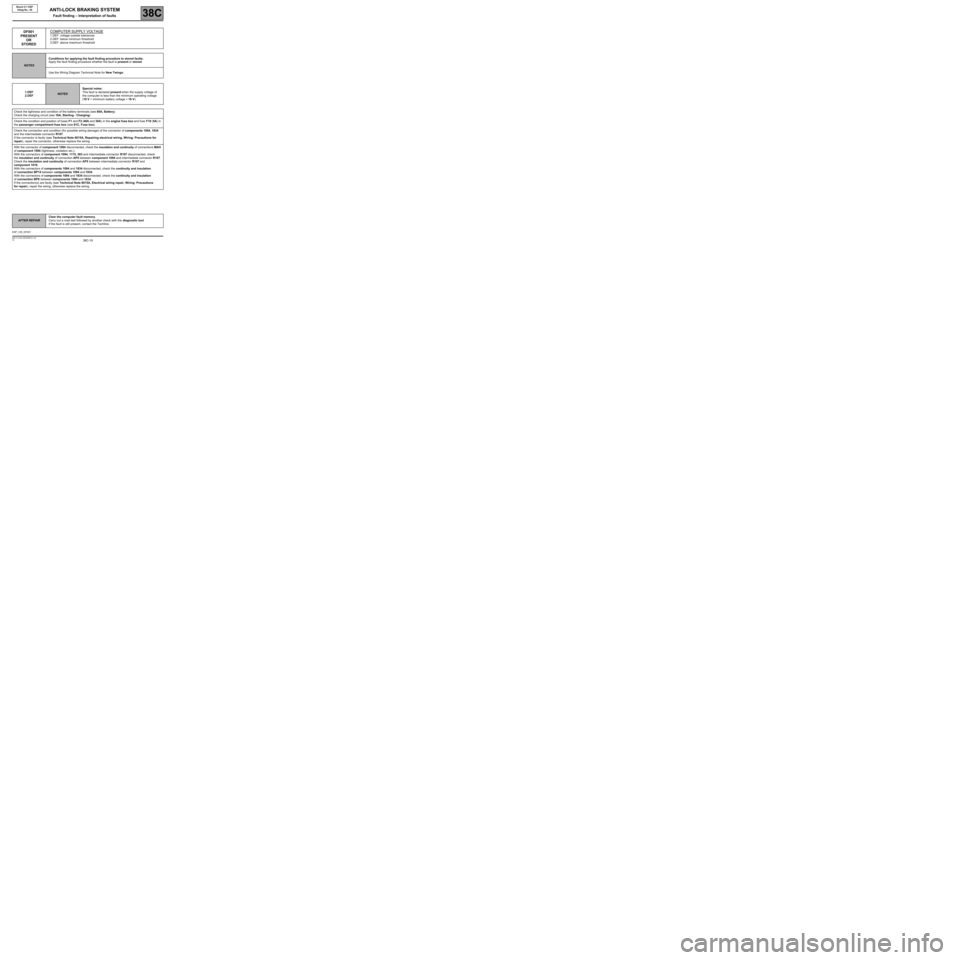
38C-19
AFTER REPAIRClear the computer fault memory.
Carry out a road test followed by another check with the diagnostic tool
If the fault is still present, contact the Techline.
V3 MR-413-X44-38C050$101.mif
38C
Bosch 8.1 ESP
Vdiag No.: 05
DF001
PRESENT
OR
STOREDCOMPUTER SUPPLY VOLTAGE
1.DEF: voltage outside tolerances
2.DEF: below minimum threshold
3.DEF: above maximum threshold
NOTESConditions for applying the fault finding procedure to stored faults:
Apply the fault finding procedure whether the fault is present or stored.
Use the Wiring Diagram Technical Note for New Twingo.
1.DEF
2.DEF
NOTESSpecial notes:
This fault is declared present when the supply voltage of
the computer is less than the minimum operating voltage
(10 V < minimum battery voltage < 16 V).
Check the tightness and condition of the battery terminals (see 80A, Battery).
Check the charging circuit (see 16A, Starting - Charging).
Check the condition and position of fuses F1 and F2 (40A and 30A) in the engine fuse box and fuse F10 (5A) in
the passenger compartment fuse box (see 81C, Fuse box).
Check the connection and condition (for possible wiring damage) of the connector of components 1094, 1834
and the intermediate connector R107.
If the connector is faulty (see Technical Note 6015A, Repairing electrical wiring, Wiring: Precautions for
repair), repair the connector, otherwise replace the wiring.
With the connector of component 1094 disconnected, check the insulation and continuity of connections MAH
of component 1094 (tightness, oxidation etc.).
With the connectors of component 1094, 1175, 583 and intermediate connector R107 disconnected, check
the insulation and continuity of connection AP5 between component 1094 and intermediate connector R107.
Check the insulation and continuity of connection AP5 between intermediate connector R107 and
component 1016.
With the connectors of components 1094 and 1834 disconnected, check the continuity and insulation
of connection BP14 between components 1094 and 1834.
With the connectors of components 1094 and 1834 disconnected, check the continuity and insulation
of connection BP8 between components 1094 and 1834.
If the connection(s) are faulty (see Technical Note 6015A, Electrical wiring repair, Wiring: Precautions
for repair), repair the wiring, otherwise replace the wiring.
ANTI-LOCK BRAKING SYSTEM
Fault finding – Interpretation of faults
ESP_V05_DF001
Page 20 of 101
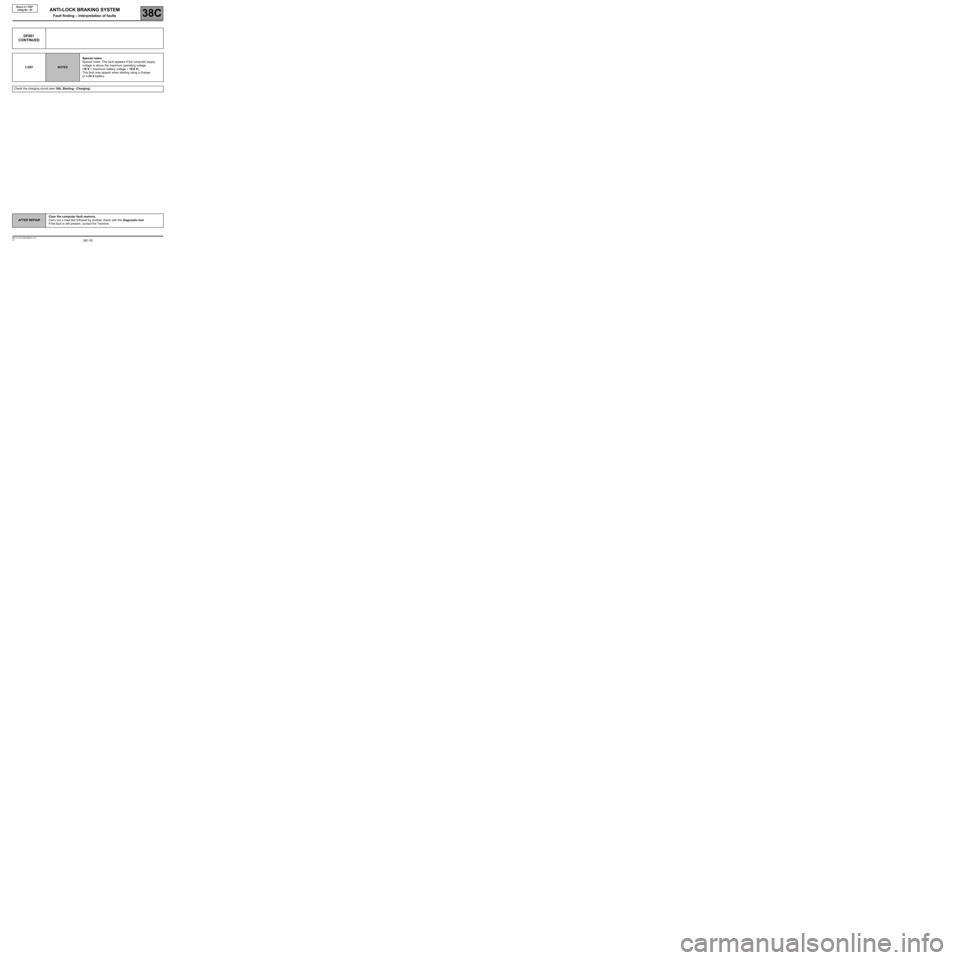
38C-20
AFTER REPAIRClear the computer fault memory.
Carry out a road test followed by another check with the diagnostic tool
If the fault is still present, contact the Techline.
V3 MR-413-X44-38C050$101.mif
ANTI-LOCK BRAKING SYSTEM
Fault finding – Interpretation of faults38C
Bosch 8.1 ESP
Vdiag No.: 05
DF001
CONTINUED
3.DEFNOTESSpecial notes:
Special notes: This fault appears if the computer supply
voltage is above the maximum operating voltage
(16 V < maximum battery voltage < 19.6 V).
This fault may appear when starting using a charger
or a 24 V battery.
Check the charging circuit (see 16A, Starting - Charging).